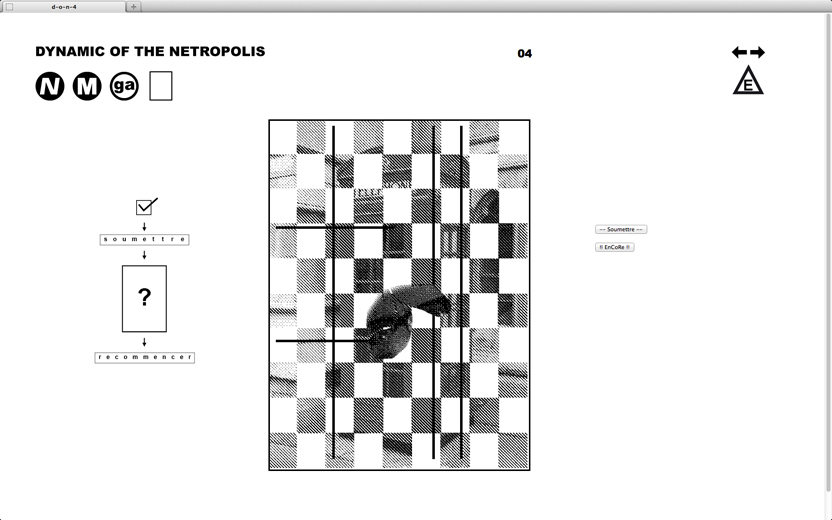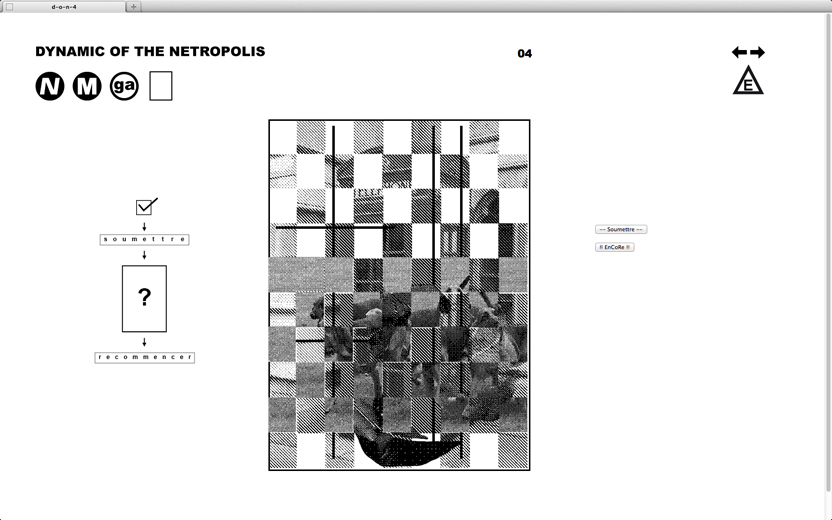2012
site web_______________________________
dynamic-of-the.net (lien)
En 1921, László Moholy-Nagy crée le scénario graphique d'un film qu'il ne réalisera jamais et l'intitule Dynamic of the Metropolis. Ces quatorze pages en noir et blanc sont à la fois un manifeste de toutes les expérimentations graphiques menées au Bauhaus dont il est l'un des professeurs (principe de la Typophoto, utilisation de typographies linéales et de formes géométriques simples,…) mais aussi un inventaire de ses propres obsessions.
Il cherche en effet à y transcrire ce bouillonnement propre aux grandes villes modernes et ses multiples stimuli simultanés qui selon lui amenèrent les organes perceptifs de leur population à évoluer afin de s'adapter à leur urgence. Le cinéma, ouvert à la fois aux images statiques et en mouvement, au son et au texte, aurait été le seul à pouvoir transcrire cet afflux nouveau de sensations.
Ce postulat ne fût cependant que théorique,car bien que l'intention soit claire et brillamment exécutée sur le papier, elle ne franchît jamais l'oeil de la caméra.
Dynamic of the NETropolis se propose donc d'être une adaptation moderne de l'œuvre de Moholy-Nagy à travers un média que celui-ci était à deux doigts de prédire: le web. Celui-ci permet en effet de pousser encore plus loin la volonté de Moholy-Nagy, notamment en matière de non-linéarité du récit qui était un point essentiel du scénario original, soucieux de traduire le hasard des sollicitations de la vie moderne réelle.
Dynamic of the NETropolis se présente donc comme une interface interactive permettant à l'utilisateur de créer sa propre version du scénario, en l'explorant page par page. Ces interactions peuvent se faire à travers des jeux de (re)constructions aléatoires ("page" 8) ou non ("pages" 10, 4 et 5),de déformations ("page"9), de remplissage ("page" 7), et enfin par une navigation dans l'espace immatériel du web qui peut s'apparenter à celle effectuée dans l'espace réel ("pages" 3 et 1) ou reprendre le code propre au web de l'hyper-lien ("page" 6).
L'adaptation de toutes les pages du scénario original est encore en création, laissant ainsi de l'espace au développement des connaissances à la fois des concepteurs et des utilisateurs.
2012
web site
-------------------------------
dynamic-of-the.net (link)
In 1921, László Moholy-Nagy creates the graphic scenario of a movie which he will never realize naming it Dynamic of the Metropolis.
These fourteen black and white pages are at the same time a manifesto of all the graphic experiments led by the Bauhaus where he is teaching but also an inventory of his own obsessions. He indeed tries to transcribe the energy of the modern big cities and there multiple simultaneous stimuli which according to him brought the perceptive organs of their population to evolve to adapt itself to their urgency.
The cinema, opened at the same time to static images and movement, to sound and text, would have been the only medium to be able to transcribe this new influx of sensations.
This postulate is however only theoretical,because although the intention is clear and splendidly executed on the paper, it never crossed the camera eye.
Dynamic of the NETropolis is thus suggested as a modern adaptation of Moholy-Nagy's work through a media which he was within an ace of predicting: the Web. This one indeed allows to push the will of Moholy-Nagy even further, in particular regarding the non-linearity of the narrative which was an essential point of the original scenario.
Dynamic of the NETropolis appears as an interactive interface allowing the user to create its own version of the scenario, by investigating it.These interactions can be made through games of random constructions ("page 8") or not ("pages 10, 4 and 5"), of distortions ("page 9"), of filling ("page 7"), and finally by the possibility of browsing in the immaterial space of Web which can be similar to that made in the real space ("pages 3 and 1") or using codes peculiar to the Web of the hyper-link ("page 6").
The adaptation of all the pages of the original scenario is still in creation, thus leaving space to the development of the knowledge of both designers and users.






















_______________________________
dynamic-of-the.net (lien)
En 1921, László Moholy-Nagy crée le scénario graphique d'un film qu'il ne réalisera jamais et l'intitule Dynamic of the Metropolis. Ces quatorze pages en noir et blanc sont à la fois un manifeste de toutes les expérimentations graphiques menées au Bauhaus dont il est l'un des professeurs (principe de la Typophoto, utilisation de typographies linéales et de formes géométriques simples,…) mais aussi un inventaire de ses propres obsessions.
Il cherche en effet à y transcrire ce bouillonnement propre aux grandes villes modernes et ses multiples stimuli simultanés qui selon lui amenèrent les organes perceptifs de leur population à évoluer afin de s'adapter à leur urgence. Le cinéma, ouvert à la fois aux images statiques et en mouvement, au son et au texte, aurait été le seul à pouvoir transcrire cet afflux nouveau de sensations.
Ce postulat ne fût cependant que théorique,car bien que l'intention soit claire et brillamment exécutée sur le papier, elle ne franchît jamais l'oeil de la caméra.
Dynamic of the NETropolis se propose donc d'être une adaptation moderne de l'œuvre de Moholy-Nagy à travers un média que celui-ci était à deux doigts de prédire: le web. Celui-ci permet en effet de pousser encore plus loin la volonté de Moholy-Nagy, notamment en matière de non-linéarité du récit qui était un point essentiel du scénario original, soucieux de traduire le hasard des sollicitations de la vie moderne réelle.
Dynamic of the NETropolis se présente donc comme une interface interactive permettant à l'utilisateur de créer sa propre version du scénario, en l'explorant page par page. Ces interactions peuvent se faire à travers des jeux de (re)constructions aléatoires ("page" 8) ou non ("pages" 10, 4 et 5),de déformations ("page"9), de remplissage ("page" 7), et enfin par une navigation dans l'espace immatériel du web qui peut s'apparenter à celle effectuée dans l'espace réel ("pages" 3 et 1) ou reprendre le code propre au web de l'hyper-lien ("page" 6).
L'adaptation de toutes les pages du scénario original est encore en création, laissant ainsi de l'espace au développement des connaissances à la fois des concepteurs et des utilisateurs.
2012
web site
-------------------------------
dynamic-of-the.net (link)
In 1921, László Moholy-Nagy creates the graphic scenario of a movie which he will never realize naming it Dynamic of the Metropolis.
These fourteen black and white pages are at the same time a manifesto of all the graphic experiments led by the Bauhaus where he is teaching but also an inventory of his own obsessions. He indeed tries to transcribe the energy of the modern big cities and there multiple simultaneous stimuli which according to him brought the perceptive organs of their population to evolve to adapt itself to their urgency.
The cinema, opened at the same time to static images and movement, to sound and text, would have been the only medium to be able to transcribe this new influx of sensations.
This postulate is however only theoretical,because although the intention is clear and splendidly executed on the paper, it never crossed the camera eye.
Dynamic of the NETropolis is thus suggested as a modern adaptation of Moholy-Nagy's work through a media which he was within an ace of predicting: the Web. This one indeed allows to push the will of Moholy-Nagy even further, in particular regarding the non-linearity of the narrative which was an essential point of the original scenario.
Dynamic of the NETropolis appears as an interactive interface allowing the user to create its own version of the scenario, by investigating it.These interactions can be made through games of random constructions ("page 8") or not ("pages 10, 4 and 5"), of distortions ("page 9"), of filling ("page 7"), and finally by the possibility of browsing in the immaterial space of Web which can be similar to that made in the real space ("pages 3 and 1") or using codes peculiar to the Web of the hyper-link ("page 6").
The adaptation of all the pages of the original scenario is still in creation, thus leaving space to the development of the knowledge of both designers and users.
The cinema, opened at the same time to static images and movement, to sound and text, would have been the only medium to be able to transcribe this new influx of sensations.






















